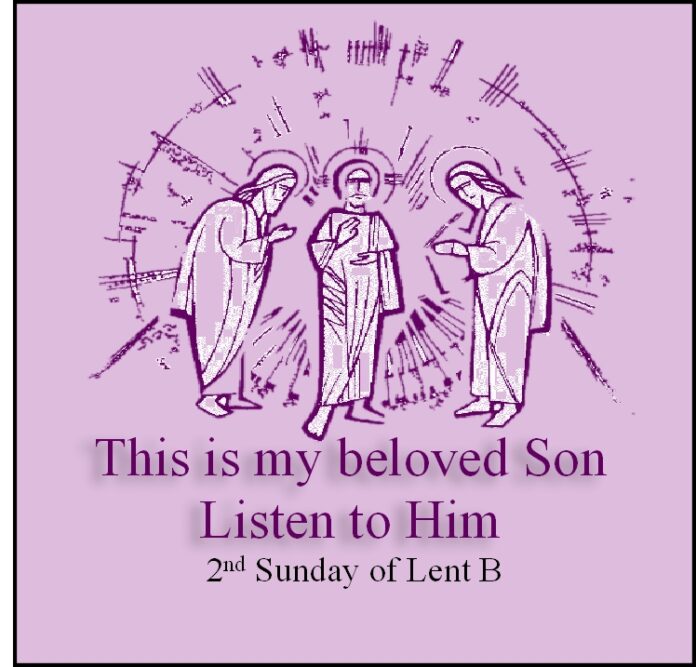28 February 2021
Genesis 22:1-2, 9, 15-18
Romans 8:31-34
Mark 9:2-10
Some of you may recall Brenda Lee’s 1960’s hit song, “Is that all there is?” I believe that the song was a hit because it echoed a common human experience of shattered dreams and disillusionment. A somewhat similar view of life was voiced by the American novelist, Thomas Wolff, when he wrote: ‘loneliness is the constant weather of our lives, Love the rare and precious flower’ (“God’s Lonely Man”). Certainly, disappointment and loneliness are part and parcel of human life. They were real experiences for Jesus too in the course of his ministry. But, as today’s gospel illustrates, there are moments when the veil between the visible and invisible worlds is lifted, and the love which makes the world go round transfigures everything and helps us cope with ‘the slings and arrows of outrageous fortune’ (Hamlet).
The story of the Transfiguration, as recounted by Mark takes place at a critical moment in the life of Jesus. He was soon to leave behind beautiful Galilee and face towards Jerusalem where he sensed that he would meet the same fate as the prophets before him. He had already warned his disciples that the Son of man would ‘be rejected by the elders and the chief priests and the scribes, and be killed, and after three days rise again’ (Mk 8: 31). And he had rebuked Peter for refusing to accept this prophesy: ‘Get behind me, Satan! Because the way you think is not God’s way but man’s’ (Mk 8:33),
Now, as was Jesus’ custom when facing into danger, he withdrew to a mountain (probably Mount Tabor) to pray and reflect, taking with him three of his disciples, Peter, James, and John. In their presence he was transfigured and, as on the occasion of his baptism by John, affirmed in his identity and messianic vocation by his Father: ‘This is my Son, the Beloved. Listen to him’ (Mk 9:7). It was surely this affirmation that gave Jesus the strength to face the dark and threatening future that lay ahead. His intense experience of the Father’s love confirmed the truth that Paul powerfully articulates in today’s second reading: ‘With God on our side, who can be against us’? (Romans 8:31).
The transfiguration experience was important not just for Jesus but even more so for his beloved disciples, Peter, James, and John. Their eyes were opened to catch a glimpse of Jesus in his glory and their ears were opened to hear the divine confirmation of Jesus’ identity as ‘beloved Son’ to whom they were enjoined to listen. Captivated by the experience, Peter wants to remain on the mountain in the exalted company of Elijah, Moses and Jesus. However, this is not to be. The luminous moment passes and the three disciples find themselves alone with Jesus who warns them not to tell anyone what they had witnessed ‘until the Son of Man had risen from the dead’ (Mk 9:9). We are told that the disciples observed his warning faithfully, but continued to reflect on what they had seen and heard, wondering what it all meant.
Today’s gospel may prompt us to recall ‘transfiguration moments’ in our own lives, moments when we catch a glimpse of a transcendent beauty beyond the horizon of the habitual. The poets capture such moments better than we can. In his poem, ‘Primrose’, Patrick Kavanagh, remembers a moment when, as a child sitting on a river bank, he found
‘One small page of Truth’s manuscript made clear.
I looked at Christ transfigured without fear –
The light was very beautiful and kind,
And where the Holy Ghost in flame had signed
I read it through the lenses of a tear.’
Seamus Heaney, in his poem ‘Postscript’, writes of a moment when, while driving along the coast in county Clare, with the wild ocean on one side and the extraordinary expanse of the Burren on the other, ‘big soft buffetings come at the car sideways / And catch the heart off guard and blow it open’. Such moments may not change us for they are always fleeting. But they do blow open our hearts to a sustaining presence that can help us cope with times of fear and uncertainty, and carry us forward in hope of a better future.
Lent is a time to remember such moments in our own lives and draw strength from them. It is a time to trust in the Lord like Abraham in our first reading, even when the odds seem stacked against us. It is a time to withdraw to the mountain with Jesus, to listen to him, and let him lead us on our journey towards Easter. I end with a reflection on mountains from the pen of Fr Flor McCarthy, SDB:
Jesus often went into the hills to pray.
He preached his most famous sermons from a hilltop.
He was transfigured on Mount Tabor, died on Mount Calvary,
and ascended to heaven from Mount Olivet.
It seems that he loves hills and mountains.
Why was this?
Was it because he grew up among the hills of Galilee?
Or was it because heights enlarge our vision and cause our spirit to soar?
Lift us up, strong Son of God, so that we may see further.
Strengthen our faith that we may see beyond the horizon.
And when the valley closes us in,
help us to remember the view from the hilltop.’
Michael McCabe SMA
Click on the play button below to listen to an alternative homily from Fr Tom Casey SMA.
|
|


You must be logged in to post a comment.